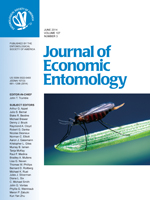Athetis lepigone (Möschler), a new lepidopteran pest in China, has spread quickly to seven provinces since it was first reported causing damage on summer maize in Hebei province in 2005. Whether this species is a migrant or not remains unknown. The past 3 yr searchlight trapping on an island in the center of Bohai Gulf provided direct evidence that both male and female A. lepigone moths migrate across the Bohai Gulf waters in northern China because no host crops or A. lepigone larvae were found on this island. The four migration waves observed in this study represent high-altitude movements of the overwintering, first, second, and third generations of A. lepigone moths, respectively. Carbon isotope analysis showed that 1.76–5.44% of the tested A. lepigone moths originated from C4 plants, which provides additional evidence that this species is a migrant because there are no C4 plants on this small island. The 89.24–96.89% of tested A. lepigone moths originated from C3 plants were significantly higher than that from C4 plants in all generations, suggesting that maize fields are not the main host sites for A. lepigone. Few females were trapped in spring and early summer with relatively high mating frequency and more advanced ovarian development, suggesting that the migration of this species is not completely bound by the “oogenesis-flight syndrome.” These findings reveal a new route for A. lepigone migrating to and from the northeastern agricultural region of China, and improve our knowledge of the migration ecology of A. lepigone. Further studies are needed to clarify the migration trajectories that will help in developing sound forecasting systems for this pest species.
How to translate text using browser tools
1 June 2014
Does Athetis lepigone Moth (Lepidoptera: Noctuidae) Take a Long-Distance Migration?
Xiaowei Fu,
Yongqiang Liu,
Yunhe Li,
Abid Ali,
Kongming Wu
ACCESS THE FULL ARTICLE
It is not available for individual sale.
This article is only available to subscribers.
It is not available for individual sale.
It is not available for individual sale.

Journal of Economic Entomology
Vol. 107 • No. 3
June 2014
Vol. 107 • No. 3
June 2014
Athetis lepigone
searchlight trapping
seasonal migration
sexual maturation
Stable carbon isotope




